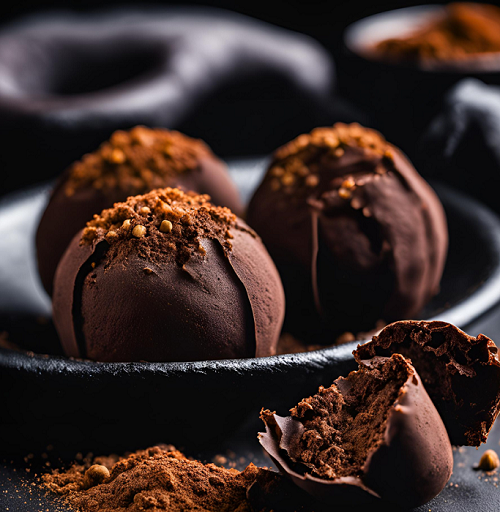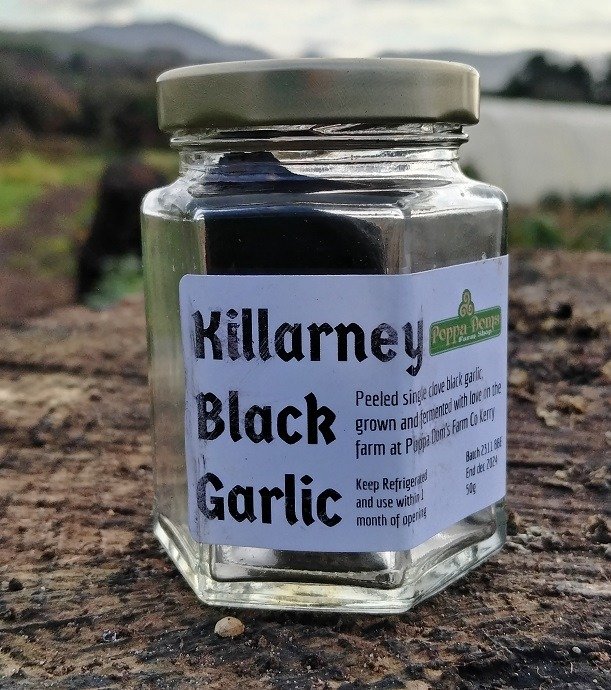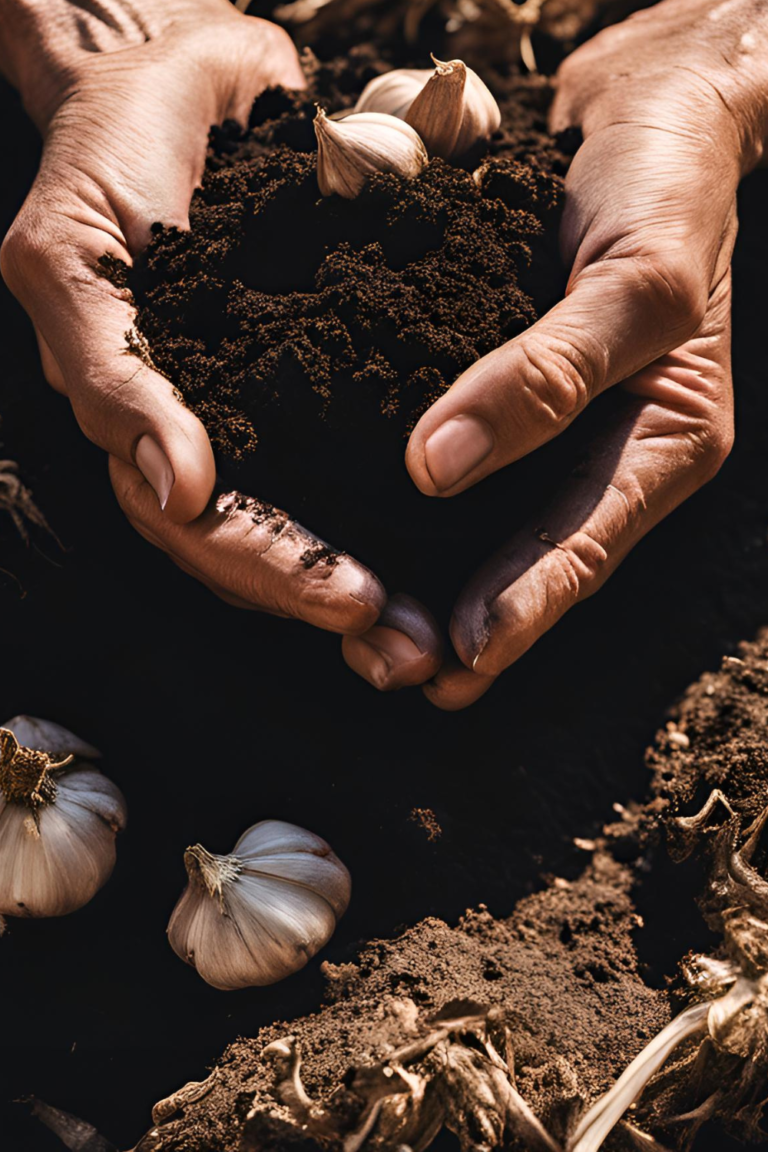


When it comes to black garlic vs. raw garlic, my grandfather’s story taught me just how different these two ingredients can be. He adored garlic—loved the taste, swore by its healing powers—but it never loved him back. Every time he indulged in a garlicky stew or dared to eat it raw, his stomach waged war. A rumbling, grumbling rebellion. He’d sigh, rub his belly, and mutter, “It’s the price we pay for good food.” But was it really?
He wasn’t alone. Plenty of people struggle with garlic’s fiery bite. That unmistakable burn on the tongue, the lingering breath that overstays its welcome, the way it sometimes turns a happy meal into an evening of regret. It’s all thanks to allicin, the very compound that gives raw garlic its sharp edge and powerful medicinal punch. While incredible for health, it can be harsh on digestion, irritating the gut lining and causing all sorts of unwanted drama.
But what if you could have all the benefits of garlic—minus the burn, the bellyaches, and the breath that could scare away vampires and dinner dates alike? Enter black garlic, the smooth, mellow, umami-packed version that transforms garlic’s wild spirit into something utterly refined. Through a slow, patient fermentation process, raw garlic is softened, its harshness tamed, its nutrients supercharged. Gone is the pungency; in its place, a deep, caramel-like sweetness with the kind of complexity that makes food lovers swoon.
So, is black garlic just a more polite, sophisticated version of its fiery cousin, or does it actually outshine raw garlic in health benefits too? Let’s unravel the mystery, starting with—
What Is Black Garlic? Understanding the Transformation Process
When it comes to black garlic vs raw garlic, the difference isn’t just skin deep—it’s a complete metamorphosis. Raw garlic starts off fiery, sharp, and intense, but with time, warmth, and patience, it transforms into something rich, mellow, and deeply complex. It’s the difference between a bold young wine and a perfectly aged vintage.
So, how does raw garlic shed its pungent past and become black garlic? It all comes down to a slow-aging process that enhances its flavor, texture, and even its health benefits.
The Maillard Reaction: Where the Magic Happens
At the heart of this transformation is the Maillard reaction, the same process that gives seared steak its rich crust and caramelized onions their deep sweetness. When raw garlic is aged under controlled heat and humidity for several weeks, its natural sugars and amino acids break down and reorganize, creating new flavors, a deep black hue, and an entirely new nutritional profile. Unlike fermentation, this process doesn’t rely on bacteria—it’s pure chemical magic.
Black Garlic vs Raw Garlic: Appearance, Texture, and Taste
The contrast in black garlic vs raw garlic is striking:
- Appearance: Raw garlic is crisp and white, while black garlic turns soft, sticky, and jet-black.
- Texture: Raw garlic has a firm bite, but black garlic becomes spreadable, almost jelly-like.
- Taste: The pungency of raw garlic is replaced with deep umami, notes of molasses, balsamic, and subtle hints of tamarind.
From Ancient Origins to Modern Kitchens
While black garlic has its roots in traditional Asian cuisine, particularly in Korea, Japan, and Thailand, it has since become a global sensation. Originally aged in clay pots or underground chambers, today’s black garlic is often made using specialized fermenters or even DIY methods like rice cookers.
No matter how it’s made, one thing is clear: when comparing black garlic vs raw garlic, this transformation is more than just a change in color—it’s a culinary rebirth.

Nutritional Profile: Black Garlic vs. Raw Garlic
If garlic had a résumé, it would be one of the most impressive in the culinary world. Packed with vitamins, minerals, and bioactive compounds, it’s been a staple in traditional medicine for centuries. But when comparing black garlic vs raw garlic, what happens to all those nutrients during the aging process? Does black garlic lose its power, or does it come back stronger, like a seasoned warrior?
Breaking Down the Nutrients
Both black and raw garlic contain essential macronutrients like carbohydrates and protein, but the magic lies in the micronutrient transformation. Raw garlic boasts high levels of vitamin C, B6, manganese, and selenium, making it a natural immunity booster. However, during the aging process, some heat-sensitive compounds, like vitamin C, may degrade slightly. But don’t worry—black garlic makes up for it in other ways.
The Power of S-Allyl Cysteine and Antioxidants
One of the most notable changes is the spike in S-allyl cysteine (SAC), a compound that enhances the absorption of allicin—the powerful sulfur compound responsible for garlic’s health benefits. Studies suggest that SAC in black garlic offers stronger antioxidant and anti-inflammatory effects compared to its raw counterpart. This means that while raw garlic hits fast with its antimicrobial punch, black garlic works more like a slow-release superfood, delivering long-term benefits to the body.
Antioxidant Overload
Raw garlic is no stranger to antioxidants, but black garlic takes it up a notch. The Maillard reaction enhances the production of polyphenols and flavonoids, increasing its overall antioxidant capacity. This means black garlic could be more effective at reducing oxidative stress and fighting free radicals—a key factor in aging and disease prevention.
Want to see black garlic in action? Check out this YouTube video on its powerful health benefits!
If you’d like to try the difference for yourself, get a jar of our ‘Killarney Black Garlic‘.
Health Benefits of Raw Garlic
Raw garlic has long been nature’s medicine cabinet in a bulb—powerful, pungent, and packed with healing properties. But let’s be honest: it’s not for the faint of heart. That sharp, fiery kick? That’s allicin, a sulfur compound responsible for both garlic’s legendary health benefits and its tendency to linger on your breath long after dinner. Yet, for those who can handle the bite, raw garlic is an absolute powerhouse when it comes to cardiovascular health, immunity, and natural healing.
A Heart’s Best Friend: Cardiovascular Support
Garlic and heart health go hand in hand, like soil and seeds. Studies show that raw garlic helps lower blood pressure, improve circulation, and reduce LDL (“bad”) cholesterol, all thanks to its high levels of allicin and sulfur compounds. By relaxing blood vessels and improving blood flow, raw garlic may reduce the risk of heart disease and strokes. For those struggling with high blood pressure, a daily clove or two—raw and crushed—could be as effective as some medications.
Your Immune System’s Secret Weapon
Ever heard the old wives’ tale that eating raw garlic wards off colds? Well, science backs it up. Raw garlic is packed with immune-boosting properties, helping to reduce the severity and duration of colds and flu. The sulfur compounds in raw garlic enhance white blood cell activity, making your body more efficient at fighting off infections. Some even swear by garlic-infused honey as a natural remedy—though fair warning, it’s not for the garlic-averse!
A Natural Antibiotic & Anti-Inflammatory Agent
Raw garlic doesn’t just fight bacteria; it actively targets harmful pathogens without harming beneficial gut flora. It’s been shown to combat E. coli, Staphylococcus, and even antibiotic-resistant bacteria. Plus, its natural anti-inflammatory properties can help with everything from joint pain to digestive issues.
Of course, the biggest downside? Raw garlic’s intense flavor and potential digestive discomfort. If you love the benefits but can’t stomach the bite, you might want to try black garlic—it offers many of the same perks, minus the pungency.
Unique Health Advantages of Black Garlic
If raw garlic is the fiery warrior of the kitchen, black garlic is its wiser, more refined counterpart—the one who’s been through the trials of time and emerged even stronger. By now, you know that black garlic undergoes a slow transformation, its sharp bite mellowing into rich, caramelized depths. But what makes it truly special isn’t just the taste—it’s the unique health benefits that raw garlic simply can’t match.
Antioxidant Overload: A Supercharged Shield
You thought raw garlic had impressive antioxidant levels? Black garlic takes things to another level. Thanks to the Maillard reaction, which occurs during the aging process, black garlic develops an even higher concentration of antioxidants, particularly polyphenols and flavonoids. These compounds help combat oxidative stress, reducing inflammation, cellular damage, and even the effects of aging. If raw garlic is a sprint, black garlic is a marathon—delivering long-lasting, slow-release protection for your body.
Cancer-Fighting Potential: The Silent Warrior
Emerging research suggests that black garlic could play a role in cancer prevention. Studies have shown that its high S-allyl cysteine (SAC) content may help inhibit the growth of certain cancer cells, including those linked to colon and lung cancer. While research is still ongoing, scientists believe black garlic’s ability to reduce oxidative stress and support immune function could make it a valuable ally in cancer prevention and recovery.
A Gut-Friendly Alternative
One of the biggest complaints about raw garlic? It can be harsh on the stomach, leading to bloating, acid reflux, and discomfort. Black garlic, on the other hand, is much easier to digest. Thanks to the aging process, its sulfur compounds transform into gentler, more bioavailable forms, making it ideal for those with sensitive digestive systems. In fact, black garlic may even support gut health by encouraging the growth of beneficial gut bacteria—something raw garlic struggles with.
Brain Health & Cognitive Support
With its high antioxidant content and ability to reduce inflammation, black garlic may also support cognitive function and protect against neurodegenerative diseases like Alzheimer’s and Parkinson’s. Some studies suggest that it helps improve memory and reduce brain fog, making it an excellent choice for those looking to support long-term brain health.
If you’re looking for a way to incorporate black garlic into your meals, why not try one of these black garlic recipes? And don’t forget, you can grab Killarney Black Garlic directly from our farm to experience the magic yourself!
Side Effects and Considerations
By now, black garlic is sounding like some kind of superfood elixir, right? But before you start adding it to everything, it’s worth remembering that even the best foods have their quirks. While black garlic is much gentler than raw garlic, there are still a few things to keep in mind—especially if you have digestive sensitivities, certain health conditions, or are on medication.
Digestive Sensitivities: Gentle, But Not Always Risk-Free
One of the biggest advantages of black garlic over raw garlic is its easy digestibility. But for some, especially those with IBS or severe acid reflux, even black garlic may cause mild bloating or discomfort in large amounts. If raw garlic has ever left you clutching your stomach in regret, try introducing black garlic slowly—perhaps with a recipe like black garlic crostini, where its effects are softened by other ingredients.

Blood-Thinning Properties & Medication Interactions
Both raw and black garlic have natural blood-thinning properties, which can be great for heart health—but not so great if you’re already on anticoagulants like warfarin or aspirin. If you take blood pressure medication, diabetes medication, or have upcoming surgery, it’s best to consult with your doctor before making black garlic a daily habit.
How Much Is Too Much?
The good news? There’s no strict upper limit on black garlic consumption. Unlike raw garlic, which can irritate the stomach in large doses, black garlic is much milder and safer to eat frequently. That said, one to two cloves a day is more than enough to enjoy its benefits without overdoing it. If you’re feeling adventurous, try using it in black garlic vinaigrette or even black garlic chocolate truffles—yes, you read that right.

Storage & Shelf Life: How to Keep It Fresh
If you’re used to keeping fresh garlic hanging in your kitchen, you might be wondering—how do you store black garlic? Since it’s already aged, black garlic has a much longer shelf life than raw garlic. Kept in an airtight container at room temperature, it can last for up to six months. For even longer storage, pop it in the fridge, or freeze whole bulbs to extend their shelf life for up to a year.
If you want to try high-quality black garlic straight from the source, check out Killarney Black Garlic—grown with love, aged to perfection.
How to Incorporate Both Types into Your Diet
Now that we’ve broken down the battle of black garlic vs raw garlic, you might be wondering—how do you actually use them? Raw garlic is a powerful, punchy ingredient that can elevate dishes with its sharp bite, while black garlic offers a mellow, umami-rich complexity. The good news? You don’t have to choose between them! Both have a place in your kitchen, and when used strategically, they can bring out the best in your cooking while maximizing their health benefits.
Raw Garlic: The Bold & Fiery Addition
Raw garlic is at its best when used fresh and uncooked, as heat can destroy allicin, the compound responsible for many of its health benefits. Try:
- Salad Dressings & Vinaigrettes – A clove of crushed garlic in a lemon-olive oil dressing adds a burst of flavor and immunity-boosting power.
- Salsas & Pestos – Blending raw garlic into a homemade pesto or salsa gives it that unmistakable zesty punch.
- Garlic Honey Infusions – A folk remedy for colds, raw garlic steeped in honey makes a potent immune-boosting syrup.
- Raw Garlic Shots – If you’re brave enough, some people swear by mincing a clove and mixing it with water or apple cider vinegar for a quick health kick.
Black Garlic: The Sweet & Savory Secret Weapon
Black garlic is a culinary chameleon—its deep, almost balsamic-like flavor works beautifully in both savory and sweet dishes. Since it’s already aged and softened, it’s best used mashed, pureed, or sliced. Try:
- Black Garlic Butter – Blend black garlic into softened butter for a rich, umami-packed spread over grilled steak or roasted mushrooms.
- Black Garlic Hummus – A twist on traditional hummus, this version adds depth without the sharpness of raw garlic.
- Sauces & Glazes – Mix black garlic into balsamic reductions, barbecue sauces, or even stir-fry glazes for an extra layer of complexity.
- Surprising Desserts – Yes, really! Black garlic’s natural sweetness pairs beautifully with dark chocolate—don’t knock it ‘til you try black garlic cheesecake.
Balancing Both for Maximum Benefit
If you want the best of both worlds, the key is to use them strategically:
- Raw garlic for quick, bold bursts of flavor and allicin benefits.
- Black garlic for slow-cooked, deeply complex flavors and a gentler health boost.
And for the ultimate garlic experience, why not try both in one dish? A great example is garlic confit—slow-cooked garlic in oil, where you can mix both varieties for an unbeatable balance of bite and depth.
Cost & Availability Considerations
While raw garlic is easy to find and affordable, black garlic is a bit more of a specialty item. If you’re eager to try top-quality black garlic, we highly recommend checking out Killarney Black Garlic—directly from our farm, aged to perfection.
Final Thoughts: Which One Should You Choose?
At the end of the day, the battle of black garlic vs raw garlic isn’t really a battle at all—it’s more of a beautiful partnership. Raw garlic is your bold, fiery healer, packed with allicin and sharp flavor, while black garlic is the smooth, umami-rich powerhouse, offering antioxidants and depth without the bite.
If you’re looking for a strong immune boost, raw garlic is your best friend—just be mindful of its strong taste and potential digestive effects. If you want something gentler on the stomach, loaded with antioxidants, and packed with gourmet appeal, black garlic is the way to go. The best part? You don’t have to choose! Using both strategically in your cooking ensures you get the full spectrum of health benefits and flavors.
If you haven’t tried black garlic yet, now is the perfect time! Whether you want to experiment with new recipes or simply enjoy its rich, mellow taste straight from the clove, we highly recommend starting with Killarney Black Garlic—grown with love, aged to perfection, and ready to elevate your meals.







